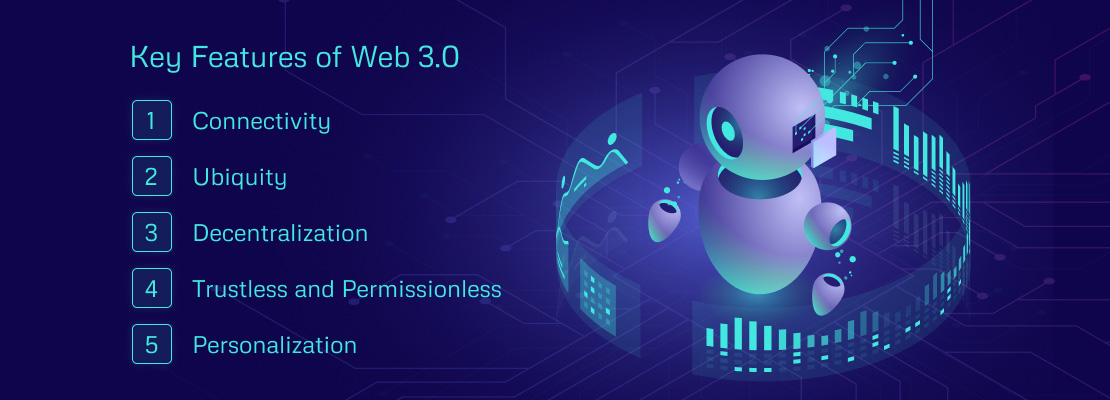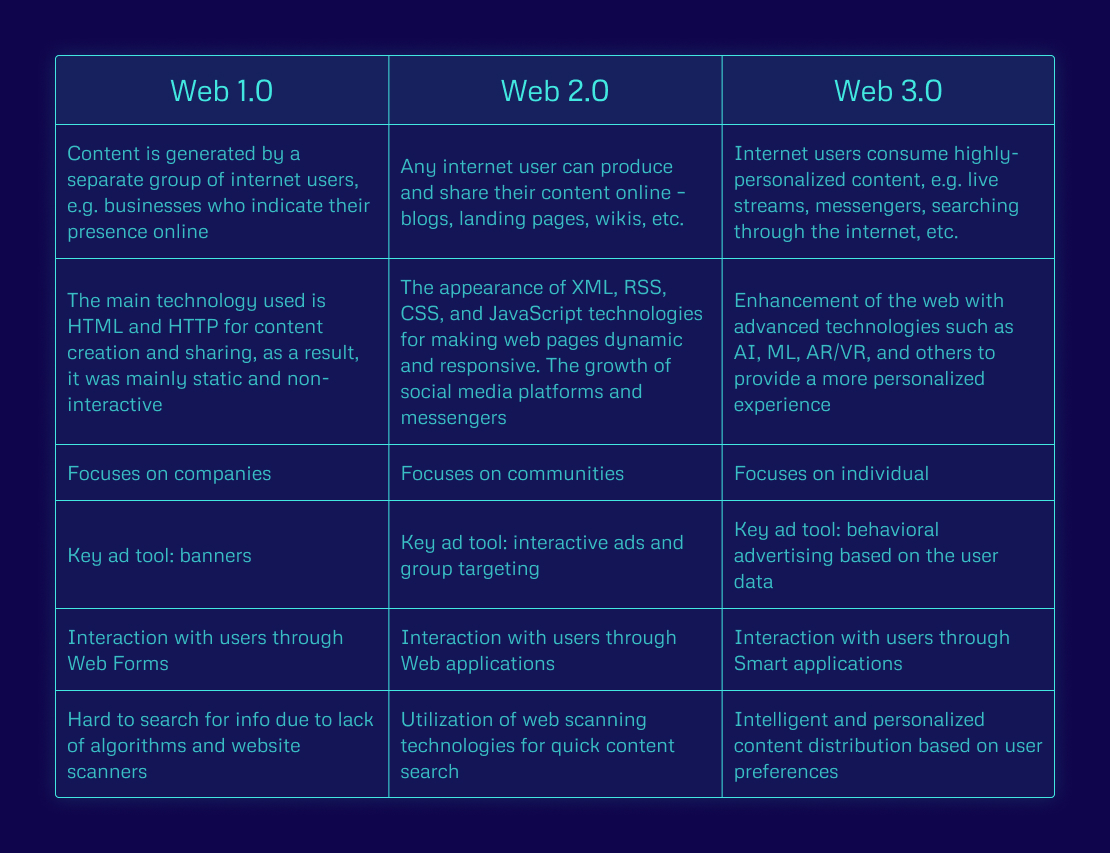How Is Web 3.0 Changing the World? SCAND Overview
Through the three decades of its existence, the Web has undergone drastic changes. It has made a fundamental transition from Web 1.0 to Web 2.0, transforming from a “read-only” to a “contribute and share” state, and much more. Today’s Web 2.0 allows all its users to create and share their text, video, and audio content, effectively interact with algorithms, quickly sort out and search through huge volumes of data, use many online services on the go, etc.
However, user demands are increasing, pushing the Web to further enhancement and the need to embrace the latest technologies to meet up to netizens’ expectations. For example, personal data security and malicious data use are among the major issues currently faced by Web 2.0 that will be easily solved with Web 3.0.
So, what to expect from Web 3.0, which technologies are reshaping the Internet evolution, and how will Web 3.0 impact business? In this article, we provide our vision on Web 3.0 and advantages it brings to the future.
What is Web 3.0?
While Web 3.0 is becoming part of a growing conversation, there is no formal definition yet as to what exactly Web 3.0 is. Meanwhile, Web 3.0 can be explained through a set of parameters it possesses and the technologies it involves.
Basically, Web 3.0 is characterized by such advanced technologies as Artificial Intelligence (AI), Machine Learning (ML), Blockchain, Internet of Things (IoT), Cloud Computing, and others. It is supposed that in Web 3.0 we’ll be able to better protect our personal data and enjoy a smooth and more efficient Internet experience with elements of computer-generated environments such as metaverses built on Virtual Reality (VR) and Augmented Reality (AR).
At the same time, by using Web 3.0 companies can ensure a more personalized user experience by shifting from audience targeting to an individual customer approach. It means that every time a business offers its services to an internet user, it nearly 100% matches and satisfies the expectations of the new-found customer.
Key Features of Web 3.0
Before moving to Web 3.0 main features, it’s important to clarify that Web 3.0 isn’t a new concept. It was predicted long ago by the founder of the World Wide Web or Web 1.0 – Tim Berners-Lee. He called it Web 3 and defined it as an intelligent and self-sufficient form of the Internet based on the three main technologies – the Semantic Web, AI, and NLP.
The Semantic Web is responsible for online data processing without human intervention. Artificial Intelligence is self-learning computer algorithms that can analyze data, build human behavioral patterns, and respond appropriately. Neuro Language Processing (NLP) is about the ability of machines to process natural languages verbally and in writing.
Definitely, many more digital technologies emerged and started contributing to the development of Web 3.0, moving it beyond the original idea of conceptualized Web 3 by Berners-Lee. Nevertheless, Web 3.0 has preserved the main features established by Tim Berners-Lee and incorporated some more.

Connectivity
This concept involves the extension of the Web outside the conventional devices we use to approach the Internet. It means that with the help of IoT, AI, and 5G mobile technologies, it’ll be possible to connect various sensors, gadgets, and appliances into Smart networks that quickly process and exchange data with each other. This way, it’ll be possible to create networks that are responsive to the environments and, in turn, can modify them in accordance with the users’ demands.
Ubiquity
Ubiquity ensures smooth data transfer among various devices. This becomes possible due to the interconnected IoT gadgets that swiftly share data with each other, providing a seamless user experience within a particular environment. Apart from this, various customer channels become closely linked to each other, ensuring a seamless omnichannel experience for their customers.
Decentralization
Decentralization changes the idea of how data is stored online. While with Web 2.0, computers address a particular server that stores the data, in Web 3.0 the information can be scattered among multiple locations simultaneously, just like in Blockchain.
This change means that the big corporations that store much data today like Google or Meta will have less power over it and, therefore, the data of its users. As a result, internet users gain more control over their own data.
Trustless and Permissionless
Web 3.0 takes these two concepts from Blockchain. The idea of trustless means that the participants of the Blockchain-based Internet can interact with each other directly, without involving any third parties. Meanwhile, permissionless means that anyone can access the Web without authorization provided by a governing body. In practice, this means that internet users remain anonymous online as they don’t share their session information via cookies. Meanwhile, they can perform different activities like data exchange, data requests, and others without asking any permission from third parties.
Personalization
In Web 3.0, personalization will reach its peak. By using AI and IoT technologies, businesses will get more information about their customers and provide them with services and offers that entirely match their demands. Companies will be able to adjust their marketing campaigns to each individual user by studying their behavioral patterns and preferences instead of targeting groups of users.
The Difference Between Web 1.0, Web 2.0, and Web 3.0
While it’s clear that Web 1.0 drastically differs from Web 3.0, it may be vague how web 3.0 is different from web 2.0. That’s because today we’re experiencing a transition from Web 2.0 to Web 3.0, therefore, the changes might not be so obvious.
Here is a summary table that includes the key differences between the three Webs.

How Web 3.0 Works and How It Will Impact the Future
As the two main concepts that define Web 3.0 are ensuring trust and safe data exchange among the Internet participants, Blockchain will become the core technology it relies on. So, how will Web 3.0 be organized?
Web 3.0 will constitute a world-wide Blockchain network with myriads of users connected to it. Each user will be anonymous in this network and will use a special entity – called a “wallet” in Blockchain – to exchange their data with other participants. Each data transfer will be registered in a block of chains that can’t be modified, removed, or hacked, once they’re added to the chain. Therefore, all the Web 3.0 participants will create a transparent, trusted, and decentralized network. It’ll be possible to:
- Save web participant data locally on the device used to enter the web instead of single servers of large corporations
- Check and verify the software used on the web as it’s code will be publicly open and transparent to all the web participants
- Assign the rights of censorship to the Web 3.0 community, taking them from global corporations
- Use one user account for authorization in different services
- Make continent more useful – the Web 3.0 participants will be able to evaluate the usefulness of the content via the democratic voting
Industry 4.0
Industry 4.0 is the term commonly used together with Web 3.0. The fourth industrial revolution is a broader notion that encompasses all the digital and technological advancements that encourage human development.
While the third industrial revolution was about the rise of electronics and telecommunications, the fourth and the latest one is focused on automation. It involves the connection of cyber and physical technologies that create the systems that will automate most of human labor.
As Industry 4.0 is gaining traction such technologies as AI/ML, IoT Robotics, and others will be more widely implemented across the industries, thereby accelerating the development of Web 3.0 as well.
Conclusion
The world is experiencing a transitioning phase from Web 2.0 to Web 3.0 now. And although this transition is still undergoing, many businesses already widely integrate the latest Web 3.0 technologies in their software solutions. They actively use IoT, AI, Blockchain, and other technologies to enhance their internal workflows, improve customer satisfaction rates, ensure smooth data sharing, and more. This allows these companies to keep a competitive edge on the market and increase their revenues.
If you’re also considering upgrading your digital solutions with tech innovations, we’ll be glad to assist you with that. Just contact us and outline your application idea.












